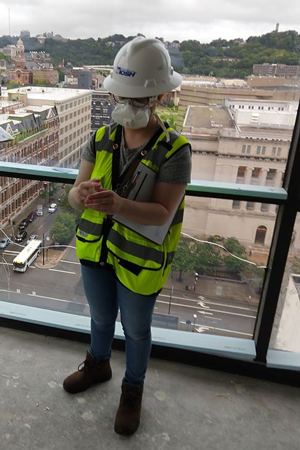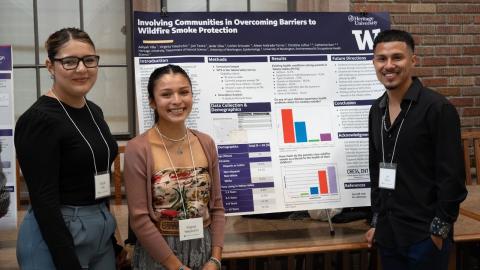Hannah Echt’s passion for public health is something of a family tradition.
Hannah Echt
MS, Occupational Hygiene
Hometown:
Cincinnati, OH
Favorite thing about Seattle:
"The public transportation is really good. You can get pretty much everywhere you need to go on the bus or light rail."
Favorite show:
iZombie. "It's set in Seattle. I started watching it before I moved here, and now I get all the references."
Future plans:
Industrial hygienist in the Hazard Evaluation and Technical Assistance branch at NIOSH
Echt was motivated to explore the field by her father's work as an industrial hygienist at the National Institute for Occupational Health and Safety (NIOSH).
While getting her BA in anthropology at Kenyon College, Echt spent summers working at NIOSH. She remembers hearing about a 20-year-old temp worker who was killed on his first day of work at a Bacardi bottling facility when he was accidentally crushed by a machine.
At the time, she was almost the same age as the worker. "In different circumstances, that could have been me, right?" she said. "It really inspired me to go out and try to prevent stuff like that from happening."
She applied to graduate programs in occupational health and chose the UW Department of Environmental & Occupational Health Sciences (DEOHS) to pursue a MS in occupational hygiene after being impressed by the department’s welcoming atmosphere.
"People here seemed really interested in getting to know me as a person," she said.
This—and a competitive funding package—sealed the deal. She received a NIOSH-funded training grant from the Northwest Center for Occupational Health and Safety (NWCOHS), housed in DEOHS, which includes tuition and a stipend that covers her living expenses.
Chemical exposure in coffee workers
Echt doesn't drink coffee herself, but she was intrigued by a java-related project in DEOHS Professor Christopher Simpson's lab soon after arriving. He studies the exposure of coffee workers to a volatile organic compound called diacetyl, which can damage the lungs when inhaled.
Diacetyl is naturally produced during coffee roasting. Because of its buttery taste, it's also been used as a synthetic flavoring agent. Exposure to the chemical is linked with a lung disease known as popcorn lung, which was identified in workers in microwave popcorn plants.
Large coffee roasting plants have also been found to have diacetyl levels that put workers at risk for popcorn lung.

Simpson wondered if workers in smaller roasters and cafes would have similar risk, especially because grinding roasted beans can release more diacetyl.
Last year, Simpson received a Safety and Health Investments Projects grant from the Washington State Department of Labor & Industries to tackle this question, and Echt took it on as her thesis project.
They worked with a small coffee roaster and cafe in Olympia to measure diacetyl levels in the cafe and in the coffee production areas, where beans are roasted, ground and packaged. They also estimated exposure to the chemical for two workers who roast, grind and package the coffee.
The researchers sampled during the busiest time of year for the business so they could estimate a worst-case scenario for exposure.
Sharing results and solutions
To their surprise, Echt and Simpson found the highest levels of diacetyl near the area where coffee beans are packaged.
They think this is because the packaging machine vibrates the ground beans, which could enhance the release of diacetyl. In this area, diacetyl levels in the air were about 35 times as great as the NIOSH recommended level of 5 parts per billion. Diacetyl levels were also greater than the recommended level in the coffee grinding area.
The researchers also found that the exposures of both workers they monitored exceeded NIOSH guidelines.
But diacetyl levels in the cafe itself were below NIOSH guidelines. Based on these low concentrations, Echt said the exposures of baristas and cafe customers are probably below levels of concern.
Grinding coffee at home for daily cups of joe would not put people at significant risk for diacetyl exposure because of the small amount of beans being ground, the researchers said.
Now they are designing local exhaust ventilation for the packaging and grinding areas to help reduce workers' exposures. When it's tested and ready, they plan to install it in the cafe.
The ventilation controls are adaptable to other craft roasting facilities, and should be relatively inexpensive, Simpson said.
Making public connections

Interacting with workers is one of Echt's favorite parts of her research. "Being able to report results back to them and either to allay their concerns, or even to help them reduce and control their exposures, that's a big motivating factor," she said.
Simpson praised his student’s ability to take leadership of project logistics and analysis, troubleshoot snags along the way, and make meaningful connections with workers.
“She dealt with whatever was thrown at her,” he said. “She is also very personable and sensitive to workers’ needs.”
Echt has also enjoyed networking at conferences like the American Industrial Hygiene Conference and Exposition, with funding from NWCOHS. She'll present a poster at the meeting in June.
Taking up the torch
Echt will graduate this spring, but she already has a job lined up at NIOSH. She'll work on a team that conducts health hazard evaluations at workplaces around the country. She's excited about the opportunity to travel, but also to return to her hometown, Cincinnati.
She recommends this path to others with an interest in worker safety.
"There are tremendous job opportunities because a lot of industrial hygienists are retiring," she said.
That includes her father, who will retire this summer after almost 30 years with the agency. Echt plans to follow in his footsteps, envisioning a long career in the public sector.
"I think that's where I can have the biggest impact," she said.



